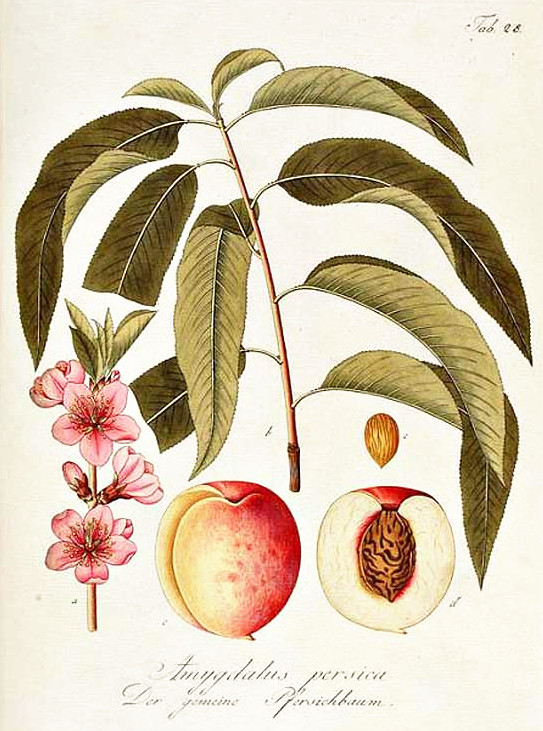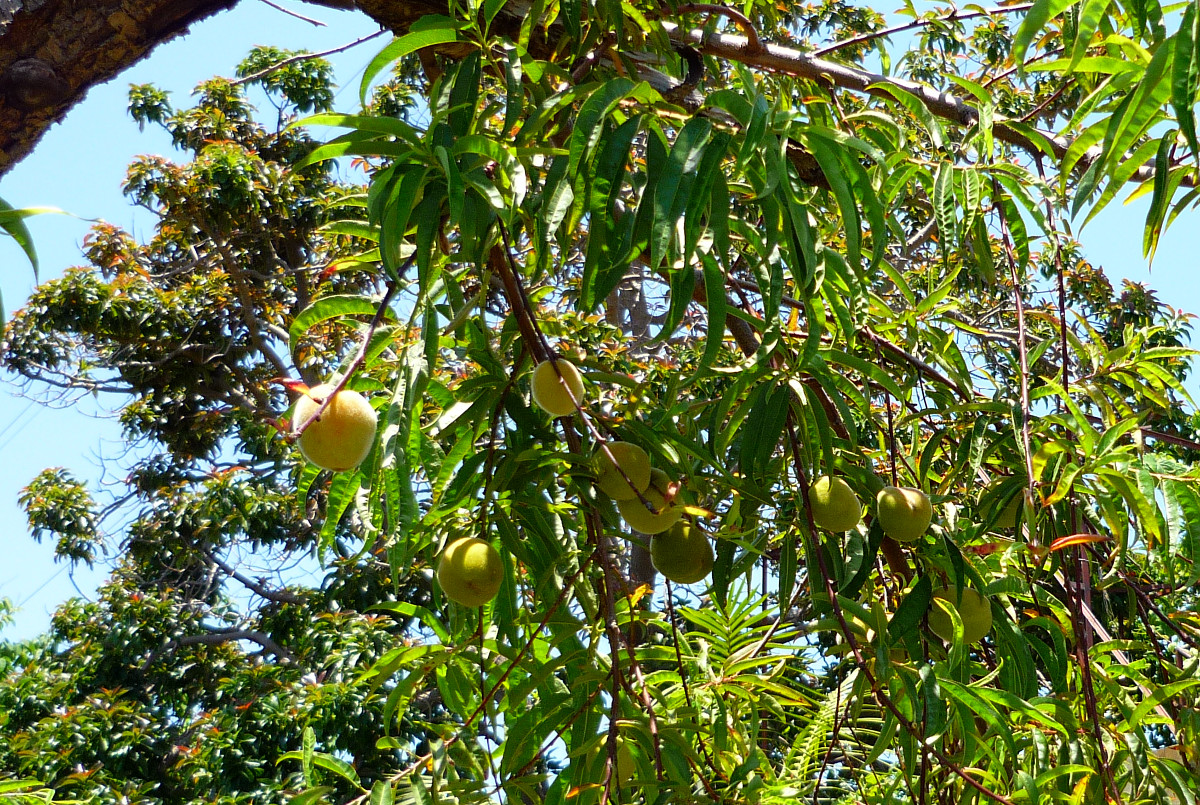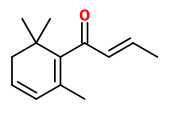Prunus persica (L.) Batsch - syn.Amygdalus persica L. - Rosaceae - peach, Pfirsich, Pfirsichbaum
Small deciduous tree, up to 4(6)m high, widely cultivated, probably native to Northwest China; leaves glabrous, lanceolate to narrow-elliptic, serrulate; flowers solitary or paired, fragrant, pale pink; fruits globose, velvety or smooth, yellow to red, edible, juicy.
„As with many other members of the rose family, peach seeds contain cyanogenic glycosides, including amygdalin (note the subgenus designation: Amygdalus).“
http://en.wikipedia.org/wiki/Peach
Prunus persica (L.) Batsch var. persica = peach, Pfirsich
Prunus persica (L.) Batsch forma compressa (syn.Prunus persica var. platycarpa) = flat peach, Plattpfirsich
Prunus persica (L.) Batsch var. nucipersica (syn. Prunus persica var. nectarina) = nectarine, Nektarine
Main components of the headspace of living peach were lower boiling esters like methyl octanoate (34.2%), Z-3-hexenyl acetate (9.7%), ethyl octanoate (7.4%), and ethyl acetate (6.2%); minor components were γ-decalactone (2.5%) and dimethyl disulfide (0.6%). Picked peaches showed the main components methyl octanoate (7.1%), ethyl octanoate (11.0%), δ-decalactone (10.6%), and γ-decalactone (39.2%).
[Mookherjee BD et al., „Fruits and Flowers: Live vs Dead - Which do we want?“, in: Nishimura, O. „Flavors and Fragrances, a world perspective.“ Proceedings of the 10th international congress of essential oils, fragrances and flavors, Washington, DC. Vol. 375. 1986, 415-424]
„Peaches (Prunus persica L., Batsch; cv. Glohaven) and nectarines (P. persica L., Batsch, var. nucipersica; cv. Maria Laura) were picked weekly from 57 days after full bloom (DAFB) to complete ripening on the tree in order to study the changes in volatile composition during fruit growth and ripening. Volatile substances were sampled from sliced pulp by dynamic headspace and analyzed by capillary Gas Chromatography (cGC) and gas chromatography/mass spectrometry. Volatile composition varied greatly, both quantitatively and qualitatively over time and between cultivars. Aldehydes, alcohols and esters showed a decreasing trend during fruit growth, with the exception of acetoin and (Z)-3-hexenol which reached the highest amounts in mature fruits. Glohaven peaches produced great amounts of lactones, mainly γ- and δ-decalactone, and γ- and δ-dodecalactone. Maria Laura nectarines produced less volatiles but more of esters and terpenoids (linalool and terpinolene) than peaches. As a consequence, nectarine aroma was more floral and fruity.“
[Volatile compound production during growth and ripening of peaches and nectarines., Visai, C., Vanoli, M., Scientia Horticulturae, Vol.70(1), 1997, 15-24]
„Application of aroma extract dilution analysis (AEDA) on a flavor extract isolated from a freshly prepared, enzyme-inactivated peach juice using solvent extraction and high-vacuum distillation (extract I) revealed 24 odor-active regions in the gas chromatogram. Flavor dilution (FD) factors ranged from 4 to 512. The highest FD factors were determined for β-damascenone (cooked-apple-like) and γ-decalactone (peach-like). Cooking of peaches for 2 h in an apparatus equipped for simultaneous steam distillation/extraction (extract II) yielded an overall more intense aroma extract (extract II). By AEDA, 30 odorants were detected in the FD-factor region of 4−16384 and were subsequently identified. The results revealed that in extract II, besides the two above-mentioned aroma compounds, both had FD factors of 16 384; δ-decalactone, γ-dodecalactone additionally, and 6-dodeceno-γ-lactone contributed with very high FD factors (FD 8192) to the overall aroma. In general, the thermal treatment led to the formation of 15 new odorants which were not detected in I. Furthermore, the lactones and β-damascenone were significantly increased in II, thereby indicating their generation from precursors in the fresh juice.“
[Differences in key odorants of handmade juice of yellow-flesh peaches (Prunus persica L.) induced by the workup procedure., Derail, C., Hofmann, T., Schieberle, P., Journal of agricultural and food chemistry, Vol.47(11), 1999, 4742-4745]
HS-SPME/GC-MS of tree-ripe ‘Fairtime’ peach flesh showed (Z)-2-hexen-1-yl acetate as main component (40%), with (Z)-4-hexen-1-yl acetate (29%) and hexyl acetate (28%).
[Changes in quality parameters and aroma volatiles compounds in ‘Fairtime’peach during fruit development and ripening., Agozzino, P., Avellone, G., Filizzola, F., Farina, V., Lo Bianco, R., Ital J Food Sci, Vol.19, 2007, 3-13]
„The quantitative distribution of volatile compounds in the skin, top mesocarp, middle mesocarp, bottom mesocarp, inner mesocarp, and outer mesocarp of a white-fleshed peach (cv. Maura) was investigated. Volatile compounds were extracted by liquid-liquid microextraction (LLME) and analyzed by GC-FID and GC-MS. The results showed that the levels of volatiles in skin were significantly higher than those observed in the other parts of the fruit, whereas top and bottom mesocarp were mainly discriminated by opposite concentrations in unsaturated lactones and C6-compounds. Distribution of lactones was also found to be different in skin and pulp according to their carbon chain length. Finally, the highest concentrations of benzaldehyde were found to be mainly located close to the stone suggesting that in peach this compound could be derived from enzymatic hydrolysis of amygdalin.“
[Distribution of the volatile compounds in the different parts of a white-fleshed peach (Prunus persica L. Batsch)., Aubert, C., Milhet, C., Food Chemistry, Vol.102(1), 2007, 375-384]
Due to their OAV, hexyl acetate, Z-3-hexenyl acetate, nonanal, γ-octalactone, 6-pentyl-α-pyrone, γ-decalactone, δ-decalactone, γ-dodecalactone, 3-methylbutanoic acid, benzaldehyde, phenylacetaldehyde, eugenol, linalool, (E)-β-damascenone, β-ionone, and (E,E)-2,4-decadienal, have been described as high-impact compounds in the essential oil of six peach and three nectarine accessions.
[Identification of key odor volatile compounds in the essential oil of nine peach accessions., Eduardo, I., Chietera, G., Bassi, D., Rossini, L., Vecchietti, A., Journal of the Science of Food and Agriculture, 90(7), 2010, 1146-1154]
HS-SPME of peach and nectarine fruit cultivars showed (R)-(+)-γ-decalactone as the predominant enantiomer (84-88%), compared to enantiomeric ratios of 89:11 and 90:10 of γ-decalactone previously detected in peach and nectarine, respectively. γ-Undecalactone was not detected in the fruit cultivars.
„Only 8/24 of the commercial peach products were found to contain natural flavours, meaning that their enantiomeric ratios of γ-decalactone were within the known boundaries, and no γ-undecalactone was detected.“
[Ravid, Uzi, et al. „Authenticity assessment of natural fruit flavour compounds in foods and beverages by auto‐HS-SPME stereoselective GC-MS.“ Flavour and fragrance journal 25.1 (2010): 20-27]
Peach fruit expresses the best aroma when completely matured. Thirteen key volatiles specifically responsible of the peaches flavor with descriptive characters such as “green”, “grass”, “leaf”, “sweet”, “fruit”, “peach-like” are: (E)-2-hexenal (green, leaf, apple, green fruity), (Z)-3-hexen-1-ol (green, leafy, green grass, fresh, fresh cut grass), (E)-2-hexen-1-ol (sharp, green, leafy, fruity, fruity, green grass), benzaldehyde (almond, sweet, spicy), (Z)-3-hexenyl acetate (green, grass), hexyl acetate (sweet, fruity), (E)-2-hexenyl acetate (green, fresh, fruity, green, leafy, sweet, waxy), γ-hexalactone (sweet, creamy), linalool (fresh floral, herbal, rosewood, petitgrain), nonanal (waxy, citrus, floral, green), decanal (citrus, orange), γ-decalactone (fruity, creamy, peach-like), δ-octalactone (creamy, fruity, coconut like). Highest odor activity values (OAV) showed hexyl acetate (OAV ~4100), (E)-2-hexenal, (Z)-3-hexen-1-ol, (E)-2-hexen-1-ol, nonanal, decanal, and γ-decalactone (all OAV >100 resp.).
[“Flavor Intensity” Evaluation of Two Peach Fruit Accessions and Their Four Offspring at Unripe and Ripe Stages by HS-SPME-GC/MS., Bononi, M., Bassi, D., Tateo, F., Food and Public Health, 2(6), 2012, 301-308] http://article.sapub.org/10.5923.j.fph.20120206.16.html
„Benzaldehyde is one of the most important molecules in the flavor industry. Presently, most of its industrial requirement is met through synthetic route. In this research, leaf essential oil of Prunus persica (L.) Batsch. extracted in different seasons was analyzed using GC-FID, GC-MS, and NMR (1H & 13C) techniques. The oil was characterised by higher amounts of benzaldehyde (63.1-98.3%). The yield of benzaldehyde was higher during rainy (0.45 g/100 g fresh leaves) and autumn (0.44 g/100 g fresh leaves) seasons. In conclusion, leaves of P. persica can be used as a natural source of benzaldehyde for flavor industry.“
[Verma, Ram S., et al. „Natural Benzaldehyde from Prunus persica (L.) Batsch.“ International Journal of Food Properties just-accepted (2017)]

Prunus persica (L.) Batsch [as Amygdalus persica L.]
Schultz, F.J., Abbildung der in- und ausländischen Bäume, Stauden und Sträuche, welche in Oestreich fortkommen, vol. 1: t. 28 (1839)
http://plantgenera.org/species.php?id_species=1266152

Peach tree, Madeira CC BY-SA 3.0, Author: Andreas Kraska


